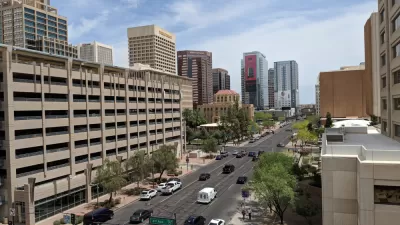Computer simulations show signs of a coming revolution with wide ranging impacts on many human endeavors, particularly cities and city planning.

Computer simulations show signs of a coming revolution. In scope and power, this new technology has important implications for the future of cities. The upcoming release of No Man's Sky will set a new standard for what can be "procedurally generated." When city planners harness this technology it will change the way we build cities by giving planners more power to see the consequences of various plans and allow systems to try more possible alternative than would be feasible by any person or team.
No Man's Sky shocked the video game press with its wild claims. The scale of its universe is such that its programmers suggest that, even if it becomes an extremely successful game with millions player logging hours of play time, 99.9% of the universe will never be explored.
The programmers built a colossal universe with 1.8 x10^19 planets, planets so huge that a character could only walk their circumference in several years time, with a sky filled with stars each of which could potentially be visited by a player. The game, which should become available later this year, is probably the vastest simulation ever created.
No Man's Sky is a procedurally generated simulation, meaning that it self-generates. Rather than creating each environment specifically, the programmers created a set of rules. These rules define a kind of cosmology for the universe of the game that allows it to create its own creatures, planets, and even planetary systems. To put this in terms of video games, a player in a Mario level runs on ground placed by a programmer and avoids enemies, each of which have been created by a human person. The No Man’s Sky's team made a program that obeys a set of rules for what the world should be like and then the program builds the world itself.
The implications of procedurally generated simulations will have far-reaching consequences for many fields of study, but clearly, tools that help simulate environments will change the way we plan for and predict the effects of our built environment.
To take one small example: planners often argue about the relative merits of two-way versus one-way streets when it comes to traffic, pedestrian safety, and environmental impacts. A procedurally generated simulation focusing on street layout could take the grid of a city and simulate every possible combination of one-ways and two-ways, including many that never would have been feasible for humans to look at. Today people often make mathematical models to try to evaluate the effect of change in one small section of street. This new type of self-generating simulation could take such a model and expand it dramatically. It could create testable prediction for the safety, environmental and traffic impact of billions of possible options. Planners could then choose only the tiny sliver of these options that were most successful or most relevant to their plans.
This precise analysis shows just a small slice of what could be achieved in such a simulation. The power of this kind of program could be let loose on any of the many city-building questions, from planning the heights of buildings to choosing the kinds of trees to plant to setting the cost of parking.
At first, these simulations will be inherently limited by our understanding of the consequences of our changes to the built environment. Any system is only as good as the assumptions it contains. But the beauty of a system like this one is that assumptions can be tweaked and improved over time. It could be modified to measure more impacts and no matter what bedrock program gets created, it could be adapted as concerns change and new information becomes available. Incorrect predictions can serve to teach the programmers and be used to improve future versions of the system. Eventually, the simulation will teach the planners how to make useful improvements to its own structure.
The idea of mapping a videogame's assumptions and processes in order to predict future outcomes hasn't just burst on the scene. For more than a decade, sports journalists have simulated games on computers to try to gain insight into the outcomes of sporting events.
A simulation built for planning wouldn't be limited by the factors that hem in a simulation designed for gaming. An interactive game like FIFA's soccer or No Man's Sky must worry about engaging and rewarding players and about creating game mechanics to allow players to connect with the imaginary world. A planner, in contrast, would be interested in the intrinsic quality and accuracy of the outcomes of simulations. Purpose-built simulations intended to create better approximations of the real world will make these gaming simulations look very crude.
It may seem as if simulations like the ones described in this article are doomed to stay prohibitively expensive. At the moment, that is probably true, but the responsibility for a creating a simulation doesn't need to rest with any one group. This technology could be offered on an open source platform, because any insights gained in creating better simulations of the real world will be useful for myriad different industries around the world. Procedurally built simulations will not remain focused on fighting space baddies for long. Many industries will wish to simulate the real world and, as they do, more of these technologies and techniques for building this kind of world will become more commonly accessible.
Costs will also continue to shrink as computing power continues to become more readily available. Finally, no individual city or entity needs to foot the bill for this on its own. A tool that can simulate cities for planners, mayors, and their citizens will be useful to a huge group of people and should not necessarily stay the purview of any single entity. There's a reason a service like Amazon has a better e-commerce platform than your local coffee roaster. That scale creates resources for a better product.
Procedural generation is not new in the world of video games. It's been a key feature behind wildly successful game design for decades. The difference is in the scale. While Blizzard Entertainment's Diablo used procedurally generated dungeons in 1996, that game functioned in a linear way. Players began at a set start point and progressed level-by-level through the game. While each player would have a slightly different experience in terms of the enemies they faced and the items they found, the variety of possible encounters was decidedly narrower than what has recently appeared on the scene.
Elon Musk's musing on the possibility that humans live inside a simulation has drawn more attention to the power of simulations. While Musk may be worried about the teleological significance of simulation, the immediate impact of these simulations should be an item of interest for all industries. Building larger worlds means better tools for predicting the consequences of our actions. This should reshape the work of city building.

Maui's Vacation Rental Debate Turns Ugly
Verbal attacks, misinformation campaigns and fistfights plague a high-stakes debate to convert thousands of vacation rentals into long-term housing.

Planetizen Federal Action Tracker
A weekly monitor of how Trump’s orders and actions are impacting planners and planning in America.

In Urban Planning, AI Prompting Could be the New Design Thinking
Creativity has long been key to great urban design. What if we see AI as our new creative partner?

King County Supportive Housing Program Offers Hope for Unhoused Residents
The county is taking a ‘Housing First’ approach that prioritizes getting people into housing, then offering wraparound supportive services.

Researchers Use AI to Get Clearer Picture of US Housing
Analysts are using artificial intelligence to supercharge their research by allowing them to comb through data faster. Though these AI tools can be error prone, they save time and housing researchers are optimistic about the future.

Making Shared Micromobility More Inclusive
Cities and shared mobility system operators can do more to include people with disabilities in planning and operations, per a new report.
Urban Design for Planners 1: Software Tools
This six-course series explores essential urban design concepts using open source software and equips planners with the tools they need to participate fully in the urban design process.
Planning for Universal Design
Learn the tools for implementing Universal Design in planning regulations.
planning NEXT
Appalachian Highlands Housing Partners
Mpact (founded as Rail~Volution)
City of Camden Redevelopment Agency
City of Astoria
City of Portland
City of Laramie






























